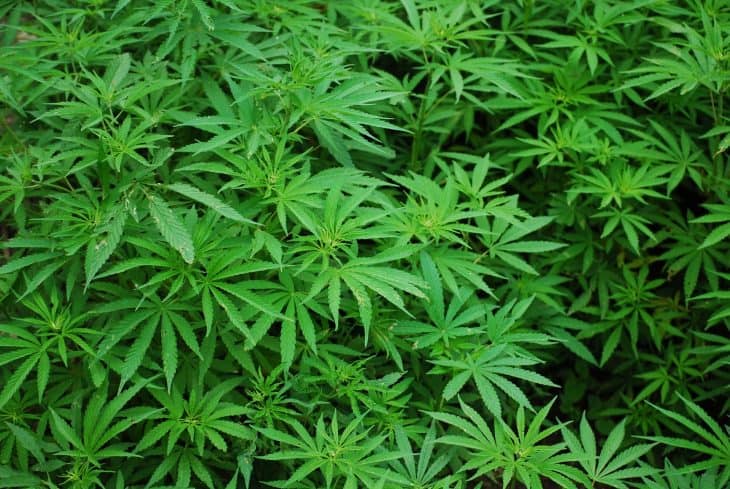
- Definition: Dried leaves, stems or flowers of the cannabis plant
- Usage: Medicine or recreational drug
- Legalization: Legal in some parts of the world
- Types: Flower, resin, and oil
- Types: Cannabis sativa, cannabis Sativa forma indica, cannabis ruderalis
- Origin: Asia
- Benefits: Relieves pain, suppresses nausea, soothes muscle spasms
- Side Effects: Short-term (e.g. Anxiety) and long-term (e.g. Reduced sexual capacity)
- Statistics: 4% of adults use marijuana occasionally
- Names: Marijuana, cannabis, pot, weed, ganja
- History: Marijuana Has Been Used for Almost 5000 Years
- Statistics: Marijuana Is the Most Used Drug in the World
- Consequences: Marijuana Use Can Cause Immune System Suppression and Personality Disorders
- Types: Smoking Is the Most Popular Method of Using Marijuana
- Chemistry: THC is the Main Psychoactive Constituent in Marijuana
- Legal States: 4 US States Allow Use of Marijuana for Non-Medical Reasons
- Prices: 1 Gram of Marijuana Typically Costs between $10 and $15
- Addictive: Marijuana Is Addictive for 25-50% of Regular Users
- Depressant: Marijuana Is Both a Depressant and a Stimulant
- Longevity: How Long Marijuana Stays in the System Depends on the Individual
- Heavy Marijuana Smokers Face Same Health Risks as Regular Tobacco Smokers
- 22 Million Pounds of Marijuana Are Produced in the US Each Year
- 9% of Electricity Use in California Is Attributed to Indoor Marijuana Growing
- Marijuana Production and Distribution in the US Emits as Much Carbon as 3 Million Cars
- People Give Marijuana to Their Pets to Ease Their Pain
- Marijuana Could Be Obtained at the General Store between 1850 and 1942
- 800,000 Arrests Are Made Each Year in the USA for Illegal Use of Marijuana
- Marijuana Use in the US Was First Restricted in 1937
- Marijuana Contains over 400 Chemicals
- It Would Take More Than 800 Joints to Kill a Person
Marijuana Facts Infographics

Marijuana Has Been Used for Almost 5000 Years
Marijuana facts reveal that the first direct reference to the use of cannabis as a means of inducing euphoria was in a Chinese medical manual from 2737 BC. Cannabis spread from China to India and North Africa in the following centuries and reached Europe in around 500 AD. Marijuana was brought to the US in the 16th century when the Europeans started conquering the New World after Christopher Columbus had (re)discovered America in the late 15th century.
Marijuana Is the Most Used Drug in the World

Marijuana facts reveal than 1 in 25 adults use marijuana occasionally and about 1 in 175 adults use it daily according to UN estimations. Marijuana is also the most popular illicit drug in the US – almost half of all Americans have tried marijuana, with about 1 in 8 admit to using it in the past year, and about 1 in 14 admit to using it in the last month.
Marijuana Use Can Cause Immune System Suppression and Personality Disorders
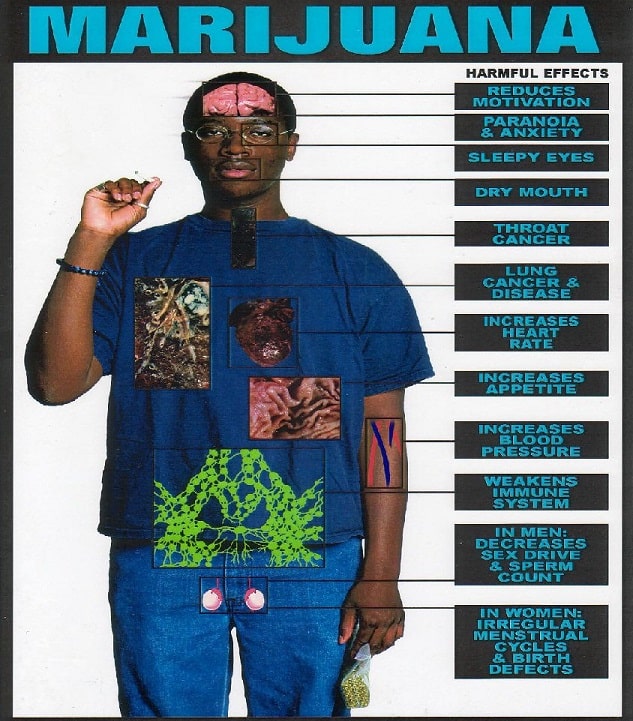
It addition to these two possible negative consequences that can greatly hinder one’s physical and mental health, regular marijuana use can also cause growth disorders, sexual disabilities in men, brain damage, mood changes, decreased intellectual capabilities and apathy.
But marijuana use doesn’t need to be regular and long-term to cause serious health issues; the most notable short-term side effects of using include panic, sensory distortion, depression, poor coordination and increased heartbeat (with increased risk of having a heart attack).
Smoking Is the Most Popular Method of Using Marijuana
In addition to smoking marijuana by using pipes, bongs or paper-wrapped joints, marijuana can also be consumed by inhaling the vapors of heated cannabis, drinking cannabis tea or eating various kinds of foods that contain cannabis, most typically in the form of cookies, oils, liquors or butter.
THC is the Main Psychoactive Constituent in Marijuana
THC (full name tetrahydrocannabinol) is the main ingredient in marijuana which causes numerous beneficial and also numerous unpleasant or potentially dangerous effects.
THC has analgesic effects, which can be utilized for soothing pain; antiemetic effects, which reduce nausea and vomiting; and it works as a mild antioxidant, decreasing the production of harmful free radicals in the body. But, unfortunately, THC is also responsible for increased appetite, psychosis, hallucinations, and impaired cognitive functions.
4 US States Allow Use of Marijuana for Non-Medical Reasons
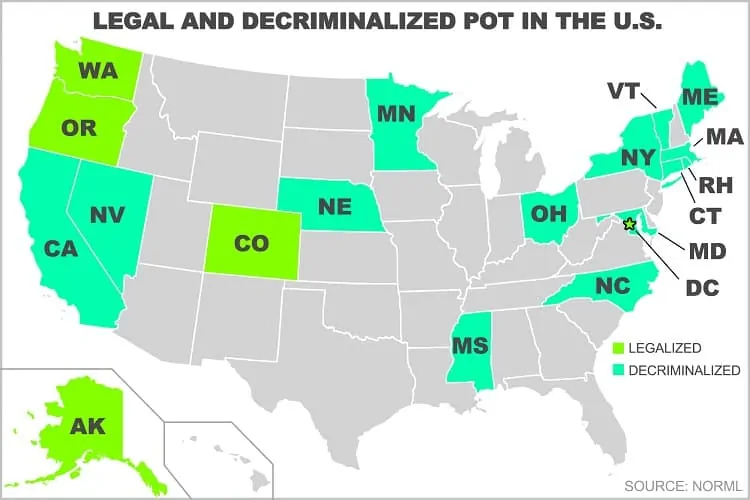
Marijuana is currently allowed for medical use to a certain degree in 23 states and Washington D.C., but recreational use is legal in only 4 US states: Alaska, Colorado, Oregon, and Washington. Washington D.C. has legalized personal use, but not commercial sale. Other states are still under the effect of the federal law, which states that it is illegal to possess, use, buy, sell, or cultivate marijuana since the Controlled Substances Act of 1970. The punishment for illegal use varies greatly from state to state, ranging from a modest fine to a few years jail time, but the trend in recent years has been to alleviate sanctions connected to illegal use of marijuana.
1 Gram of Marijuana Typically Costs between $10 and $15
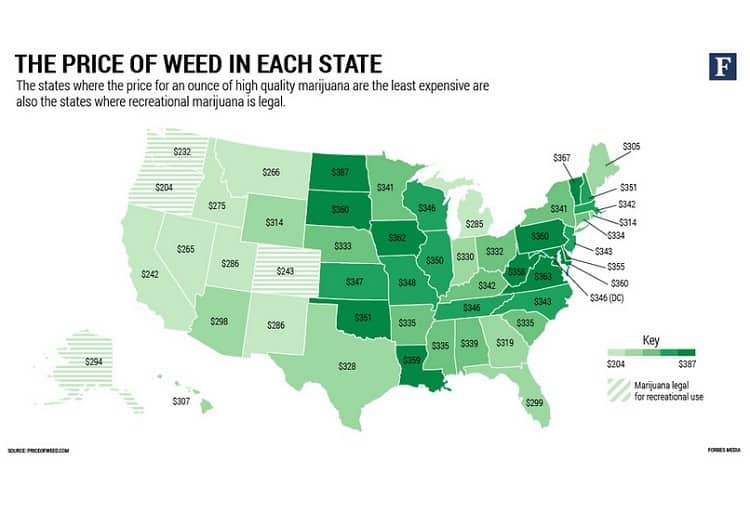
This is the retail price in most legal stores in the states where cannabis can be legally sold. Street prices can vary greatly, from less than $2 per gram to $15 per gram, depending on the quality and the quantity bought. Prices in Europe are comparable and can range from €2 to €20 per gram, although most European countries report prices typically being between €4 and €10 per gram.
Marijuana Is Addictive for 25-50% of Regular Users
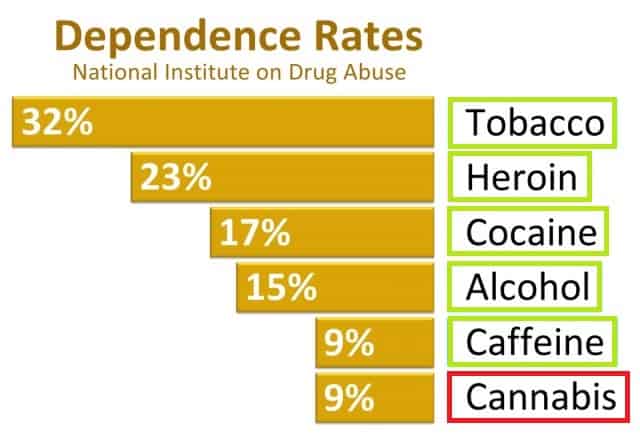
Without regular, daily use, it is estimated to be less addictive – only in about 9% of cases – but the number goes up if users start young. About 17% of teens who smoke marijuana become addicted. All in all, marijuana is responsible for 60% of illicit drug addictions in the US, with over 4 million marijuana addicts among 7 million total illicit drug addicts.
Marijuana addiction is linked to a mild withdrawal syndrome, which is usually expressed in the form of irritability, sleep problems, decreased appetite and mood swings. It generally lasts up to 2 weeks.
Marijuana Is Both a Depressant and a Stimulant
Just like alcohol, marijuana can also serve as both a stimulant and a depressant. On one hand, marijuana affects neurotransmitters and decreases their sensitivity, and on the other, it causes the feeling of euphoria, which is clearly stimulating. Which one prevails depends on the intensity of the cannabis, its type, quantity, frequency of using, and the personal characteristics of the user.
How Long Marijuana Stays in the System Depends on the Individual
This can be attributed to different metabolism levels of THC and other active ingredients in marijuana. But studies reveal typical detection times in different types of marijuana users: occasional users will likely test positive for 1 to 3 days after consumption, and possibly also on the fourth day; regular users typically test positive for a week to 10 days, and extreme cases can also test positive for a month or two after consumption. It is worth noting that urine tests that are most frequently used in marijuana detection don’t measure the concentration of THC but the concentration of its metabolite, THC-COOH after it has been processed by the liver.
Heavy Marijuana Smokers Face Same Health Risks as Regular Tobacco Smokers
Although marijuana smoking brings some health benefits, the process of frequently inhaling smoke poses the same risks for marijuana smokers and tobacco smokers, with the most common being various respiratory illnesses, according to smoking and marijuana facts.
22 Million Pounds of Marijuana Are Produced in the US Each Year
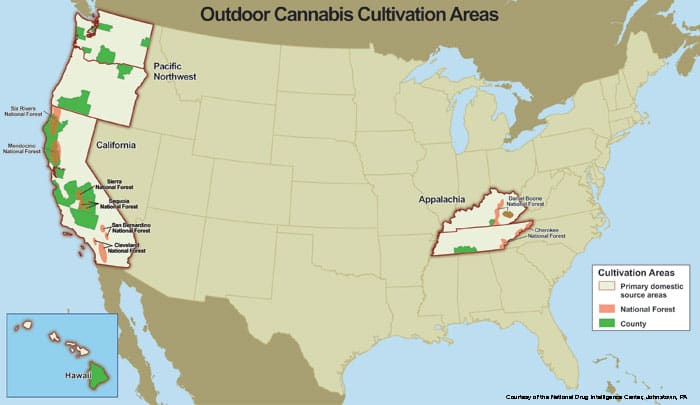
Shockingly, 80% of this production comes from only 5 states: California, Tennessee, Kentucky, Hawaii, and Washington. Personal use of cannabis is legalized only in the state of Washington out of this group.
9% of Electricity Use in California Is Attributed to Indoor Marijuana Growing
This might sound ridiculous at first, but if you consider the fact that an indoor growth module that can accommodate up to 4 cannabis plants uses as much electricity as almost 30 refrigerators, these statistics become more plausible. Nationwide, indoor growth of marijuana is estimated to use enough electricity to power 1.7 million homes, which means that about 7 large power plants are needed just for growing marijuana.
Marijuana Production and Distribution in the US Emits as Much Carbon as 3 Million Cars
Marijuana facts show that for every pound of indoor-grown marijuana, about 4,600 pounds of CO2 gets emitted into the atmosphere. Multiplying that by 22 million (as is the estimated yearly produce of marijuana in pounds) brings the total CO2 emissions to a whopping 100 billion pounds.
People Give Marijuana to Their Pets to Ease Their Pain

The American Veterinary Medical Association reports that pet owners give their cats and dogs marijuana to ease their suffering from pain. Pets usually stay under the influence for a few hours, but veterinarians warn that marijuana can be deadly for pets if given in large quantities.
Marijuana Could Be Obtained at the General Store between 1850 and 1942
Since it was listed as a useful medicine for nausea, rheumatism and labor pains in the US Pharmacopoeia, marijuana could be easily bought in some general stores and pharmacies around the country. But it was not until 1996 that medical marijuana became legally allowed in California with a valid prescription, and until 2003 in Canada that it was offered to all patients who suffered from pain.
800,000 Arrests Are Made Each Year in the USA for Illegal Use of Marijuana
These statistics include all marijuana-related offenses, but 90% of these arrests were based on illegal possession.
Marijuana Use in the US Was First Restricted in 1937
In 1937, the Marijuana Tax Act was passed, restricting the use of marijuana for medical and recreational purposes. But the law did not actually prohibit the use of marijuana; it only imposed such a heavy tax that commercial sale became nearly impossible.
Marijuana Contains over 400 Chemicals
Marijuana facts reveal that out of these 400, only 80, called cannabinoids, are unique to the cannabis plant. For comparison: there are over 4,000 chemicals in tobacco smoke…
It Would Take More Than 800 Joints to Kill a Person
And even then, the death would occur from carbon monoxide poisoning and not from THC itself, which is far from being dangerously toxic for humans. However, marijuana smoking can greatly increase the heart rate and potentially cause a heart attack, even in the short term, and deadly respiratory diseases in the long term.
Marijuana Facts – Facts about Marijuana Summary
 Marijuana is produced from the cannabis plant and can be consumed by smoking, eating, drinking or inhaling vapor. Although it is nowadays frequently used for medicinal purposes to ease pain, it still carries numerous health risks. But despite that, marijuana is the most popular drug in the world and has become legal again in some countries of the world in recent decades. Currently, there are 4 US states that allow sales and use of marijuana for recreational purposes (1 gram typically costs $10 to $15), but the majority of it is still produced in states where marijuana is not legalized, such as California, where a ridiculously high amount of energy is used for indoor marijuana production.
Marijuana is produced from the cannabis plant and can be consumed by smoking, eating, drinking or inhaling vapor. Although it is nowadays frequently used for medicinal purposes to ease pain, it still carries numerous health risks. But despite that, marijuana is the most popular drug in the world and has become legal again in some countries of the world in recent decades. Currently, there are 4 US states that allow sales and use of marijuana for recreational purposes (1 gram typically costs $10 to $15), but the majority of it is still produced in states where marijuana is not legalized, such as California, where a ridiculously high amount of energy is used for indoor marijuana production.
Was this page helpful?
Our commitment to delivering trustworthy and engaging content is at the heart of what we do. Each fact on our site is contributed by real users like you, bringing a wealth of diverse insights and information. To ensure the highest standards of accuracy and reliability, our dedicated editors meticulously review each submission. This process guarantees that the facts we share are not only fascinating but also credible. Trust in our commitment to quality and authenticity as you explore and learn with us.
